
Bugs Bunny is a fictional character created in the late 1930s at Warner Bros. Cartoons and voiced originally by Mel Blanc. Bugs is best known for his featured roles in the Looney Tunes and Merrie Melodies series of animated short films, produced by Warner Bros. Earlier iterations of the character first appeared in Ben Hardaway's Porky's Hare Hunt (1938) and subsequent shorts before Bugs's definitive characterization debuted in Tex Avery's A Wild Hare (1940). Bob Givens, Chuck Jones, and Robert McKimson are credited for defining Bugs's design.

Cecil Turtle is a fictional character in the Warner Bros. Looney Tunes and Merrie Melodies series of films. Though he made only three theatrical appearances, Cecil has the unusual distinction in that he is one of the very few characters who were able to outsmart Bugs Bunny, and the only one to do so three times in a row and at the rabbit's own game. Cecil often gives Bugs the taunting nickname of "Speedy" when addressing the rabbit.

Hare Brush is a 1955 Warner Bros. Merrie Melodies animated short directed by Friz Freleng. The short was released on May 7, 1955, and stars Bugs Bunny and Elmer Fudd.
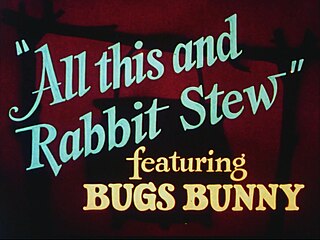
All This and Rabbit Stew is a 1941 Merrie Melodies cartoon directed by Tex Avery. The cartoon was released on September 13, 1941, and features Bugs Bunny.

False Hare is a 1964 Warner Bros. Looney Tunes animated short directed by Robert McKimson. The short was released on July 18, 1964, and stars Bugs Bunny.

Hair-Raising Hare is a Warner Bros. Merrie Melodies cartoon, released on May 25, 1946. It was directed by Chuck Jones and written by Tedd Pierce. It stars Bugs Bunny and features the first appearance of Chuck Jones' orange monster character "Gossamer".
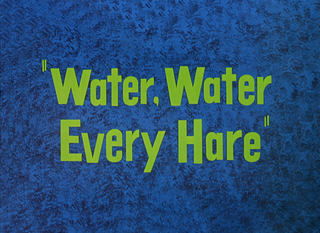
Water, Water Every Hare is a 1952 Warner Bros. Looney Tunes cartoon directed by Chuck Jones. The cartoon was released on April 19, 1952 and stars Bugs Bunny. The short is a return to the themes of the 1946 cartoon Hair-Raising Hare and brings the monster Gossamer back to the screen.

The Looney Looney Looney Bugs Bunny Movie is a 1981 American animated comedy package film with a compilation of classic Looney Tunes/Merrie Melodies Warner Bros. cartoon shorts and animated bridging sequences produced and directed by Friz Freleng, hosted by Bugs Bunny. The new footage was produced by Warner Bros. Animation. It was the first Looney Tunes/Merrie Melodies film with a compilation of classic cartoon comedy shorts produced by Warner Bros. Animation.
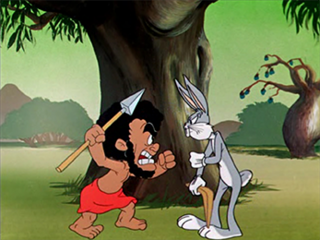
Bushy Hare is a 1950 Warner Bros. Looney Tunes cartoon directed by Robert McKimson. The short was released on November 18, 1950, and stars Bugs Bunny.
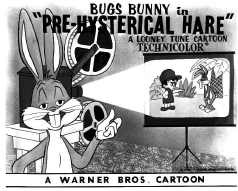
Pre-Hysterical Hare is a 1958 Warner Bros. Looney Tunes cartoon directed by Robert McKimson and written by Tedd Pierce. The short was released on November 1, 1958, and stars Bugs Bunny and Elmer Fudd. The two are in their usual hunter-and-bunny antics, but set in the Stone Age.

Buccaneer Bunny is a 1948 Looney Tunes cartoon directed by Friz Freleng. The short was released on May 8, 1948, and features Bugs Bunny and Yosemite Sam.

Devil May Hare is a 1954 Warner Bros. Looney Tunes cartoon directed by Robert McKimson. The short was released on June 19, 1954, and stars Bugs Bunny and the Tasmanian Devil making his debut.
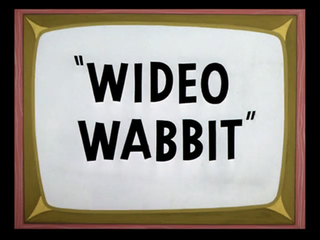
Wideo Wabbit is a 1956 Warner Bros. Looney Tunes cartoon directed by Robert McKimson. The short was released on October 27, 1956, and stars Bugs Bunny and Elmer Fudd. In the film, Bugs volunteers for an appearance in a television show hosted by Elmer. He is unaware that this is a show about hunting techniques, and he volunteered to become a hunter's prey.
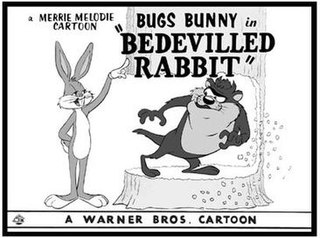
Bedevilled Rabbit is a 1957 Warner Bros. Merrie Melodies short directed by Robert McKimson. The short was released on April 13, 1957, and stars Bugs Bunny. In this cartoon, Bugs is lost in Tasmania, and has to deal with the Tasmanian Devil.
Hare-Way to the Stars is a 1958 American animated science fiction comedy short film directed by Chuck Jones and written by Michael Maltese. The short was released by Warner Bros. Pictures on March 29, 1958 as part of the Looney Tunes series, and stars Bugs Bunny and Marvin the Martian. The title is a play on the song "Stairway to the Stars."
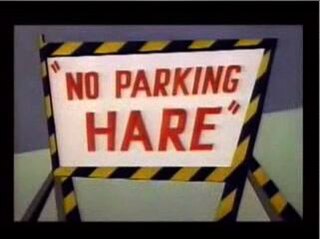
No Parking Hare is a 1954 Warner Bros. Looney Tunes theatrical animated short, directed by Robert McKimson and written by Sid Marcus. The short was released on May 1, 1954, and stars Bugs Bunny. Similar in plot to Homeless Hare, Bugs finds himself squaring off against a construction worker who wants to build over his hole in the ground.

To Hare is Human is a 1956 Warner Bros. Merrie Melodies cartoon directed by Chuck Jones. The short was released on December 15, 1956, and stars Bugs Bunny and Wile E. Coyote. In this film, Wile builds a UNIVAC computer, and grows to rely on its answers.
The Fair-Haired Hare is a 1951 Warner Bros. Looney Tunes cartoon starring Bugs Bunny and Yosemite Sam. Released April 14, 1951, the cartoon was directed by Friz Freleng. The voices were performed by Mel Blanc.

Foxy by Proxy is a 1952 Merrie Melodies cartoon directed by Friz Freleng. The short was released on February 23, 1952, and features Bugs Bunny and Willoughby the Dog, in the latter's last appearance. Mel Blanc voices Bugs Bunny, while an uncredited Stan Freberg voices Willoughby and one of the dogs that talks in the short. This cartoon is considered a remake to Of Fox and Hounds from 1940; in fact, the opening sequence was "borrowed" directly from the original.

Now Hare This is a 1958 Warner Bros. Looney Tunes cartoon directed by Robert McKimson and written by Tedd Pierce. The short was released on May 31, 1958, and stars Bugs Bunny.

















